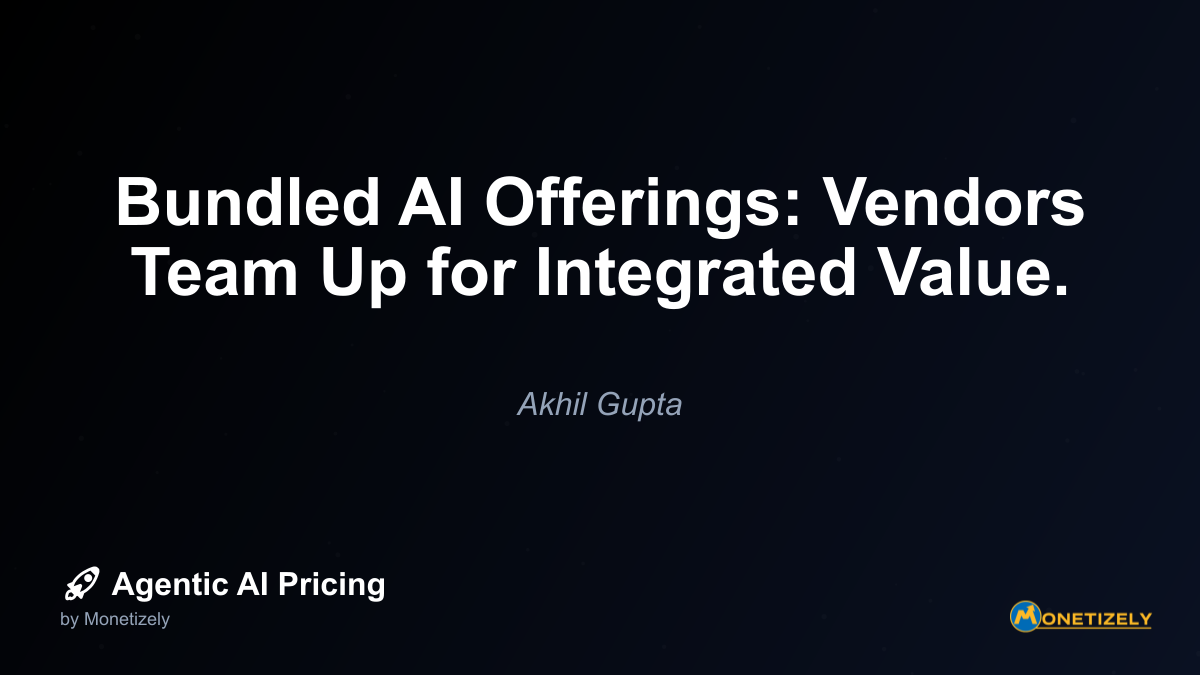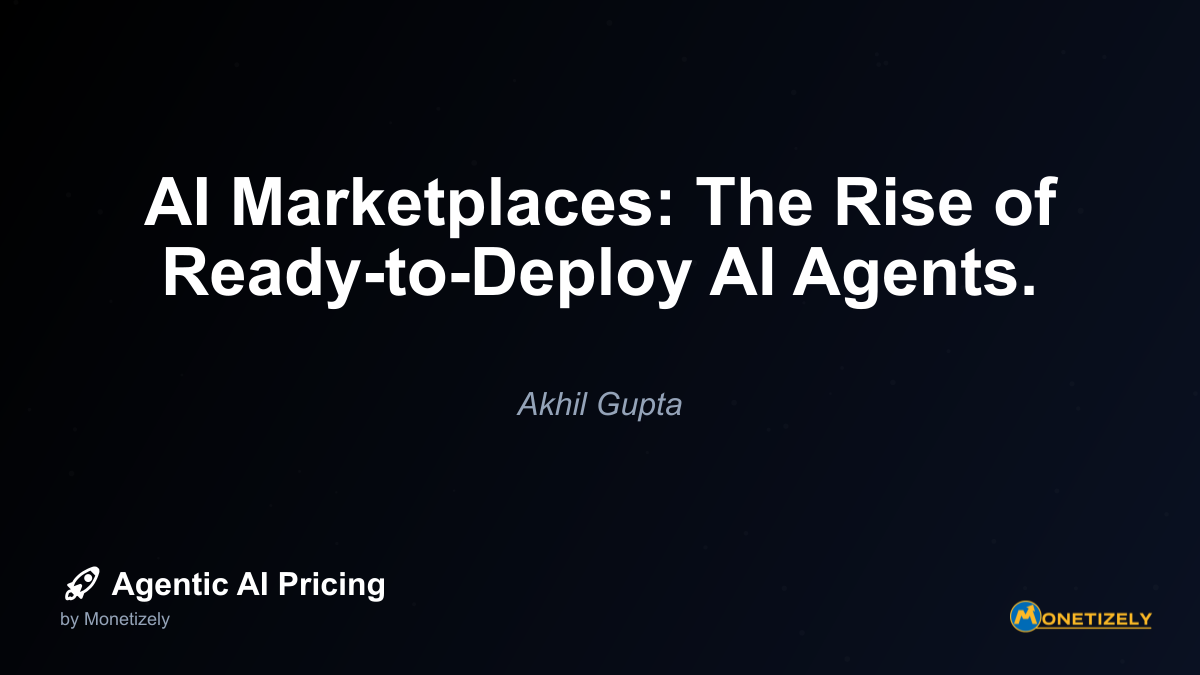· Ajit Ghuman · Emerging Trends · 10 min read
Collaborative Solutions: Multi-Vendor AI Offerings and Pricing.
AI and SaaS Pricing Masterclass
Learn the art of strategic pricing directly from industry experts. Our comprehensive course provides frameworks and methodologies for optimizing your pricing strategy in the evolving AI landscape. Earn a professional certification that can be imported directly to your LinkedIn profile.

In the rapidly evolving landscape of artificial intelligence, collaboration has emerged as a powerful strategy for delivering comprehensive solutions that address complex business challenges. As AI capabilities expand and specialize, no single vendor can realistically provide best-in-class solutions across every domain. This reality has given rise to an ecosystem of partnerships, integrations, and multi-vendor collaborations that are reshaping how AI solutions are developed, delivered, and—perhaps most significantly—priced.
The traditional model of standalone AI products with straightforward licensing is giving way to more nuanced arrangements where multiple AI providers contribute to a unified solution. This shift raises important questions about value attribution, revenue distribution, and optimal pricing strategies that balance competitiveness with profitability.
For business leaders navigating this landscape, understanding the emerging models for multi-vendor AI pricing isn’t merely academic—it directly impacts technology investment decisions, partnership strategies, and ultimately, the value derived from AI implementations. Let’s explore how these collaborative solutions are transforming the AI marketplace and what it means for vendors and customers alike.
The Market Forces Driving Multi-Vendor AI Collaborations
Several converging factors are accelerating the trend toward collaborative AI solutions:
Increasing AI Specialization
As AI technology matures, we’re witnessing greater specialization across the field. Companies are developing deep expertise in specific domains rather than attempting to excel across all AI applications. This specialization creates natural opportunities for complementary partnerships.
For example, one vendor might offer superior natural language processing capabilities while another excels at computer vision. Together, they can deliver a multimodal AI solution that neither could provide independently with the same level of sophistication.
Customer Demand for Integrated Solutions
Enterprise customers increasingly resist the complexity and overhead of managing multiple disconnected AI systems. They’re demanding cohesive solutions that work together seamlessly, even if components come from different providers.
This preference for integration creates market pressure for vendors to collaborate rather than compete across every dimension. The “best-of-breed” approach is evolving toward “best-of-breed ecosystem” where interoperability becomes a competitive advantage.
Technical Necessity for Collaboration
Some AI challenges are simply too complex for any single vendor to solve effectively. Consider autonomous vehicles, which require expertise in sensor technology, real-time data processing, predictive analytics, and specialized hardware. The technical complexity necessitates collaboration between specialists in each domain.
Competitive Pressures
Smaller, specialized AI vendors face significant challenges competing against tech giants with vast resources. Strategic partnerships allow these smaller players to participate in larger opportunities while focusing on their core strengths.
Emerging Models for Multi-Vendor AI Pricing
As collaborations between AI providers become more common, new pricing approaches are emerging to accommodate these arrangements. Let’s examine the most significant models:
Bundle Pricing for Integrated Solutions
The most straightforward approach to multi-vendor pricing is bundling, where complementary AI services are packaged together at a price point that’s lower than purchasing each component separately.
This model offers several advantages:
- Simplified purchasing for customers who receive a single contract and invoice
- Perceived value enhancement through the “package discount” psychology
- Reduced sales friction by eliminating multiple procurement cycles
However, bundle pricing raises important questions about revenue allocation between partners. The distribution formula might consider factors such as:
- The perceived value contribution of each component
- Development and operational costs incurred by each partner
- Sales and marketing contributions from each party
- Strategic importance of the partnership to each organization
For example, a document processing solution might combine one vendor’s OCR technology with another’s natural language understanding capabilities. The bundle might be priced at $100,000 annually, with 40% allocated to the OCR provider, 45% to the NLU provider, and 15% to the integration partner who maintains the unified solution.
Revenue-Sharing Agreements
More sophisticated than simple bundling, revenue-sharing agreements tie compensation directly to the value created by the collaborative solution. These arrangements are particularly appropriate when:
- Multiple AI systems contribute to a single business outcome
- The relative value contribution of each component is variable
- Usage patterns across components may differ significantly
Revenue-sharing typically involves establishing a pool of revenue from customer payments, then distributing that pool according to predetermined formulas. The distribution might be based on:
- Fixed percentages negotiated in advance
- Usage metrics for each component
- Performance against defined KPIs
- Value-based attribution models
A practical example is a customer service AI solution that combines one vendor’s chatbot technology with another’s sentiment analysis and a third’s knowledge base system. Rather than charging separately for each component, the vendors might agree to share revenue based on the number of customer interactions handled, with adjustments for complexity and resolution rates.
Consumption-Based Collaborative Pricing
This model extends the popular pay-as-you-go approach to multi-vendor scenarios. Each component in the solution charges based on relevant usage metrics, but with coordinated pricing to ensure the overall solution remains competitive.
The key challenge here is aligning the consumption metrics across different components. For instance, if one vendor charges per API call while another charges per gigabyte processed, customers may find it difficult to predict total costs.
Successful implementations typically involve:
- Harmonized measurement units where possible
- Transparent cost attribution
- Volume discounts that apply across the entire solution
- Simplified reporting that shows consumption across all components
Outcome-Based Pricing for Multi-Vendor Solutions
Perhaps the most sophisticated approach, outcome-based pricing ties compensation directly to the business results achieved by the collaborative solution. This model aligns vendor incentives with customer success but requires careful design to fairly attribute outcomes to different components.
For example, an AI solution for manufacturing quality control might combine computer vision, anomaly detection, and predictive maintenance capabilities from different vendors. Instead of charging for each component, the vendors might collectively price based on:
- Reduction in defect rates
- Improvement in production throughput
- Decrease in unplanned downtime
- Cost savings from prevented failures
The revenue distribution would then reflect each component’s contribution to these outcomes, potentially using sophisticated attribution models to determine fair allocation.
Implementation Challenges in Multi-Vendor Pricing
While collaborative pricing models offer compelling advantages, they also present significant challenges that must be addressed:
Value Attribution Complexity
Determining each vendor’s contribution to the overall solution value can be technically and politically challenging. Questions arise such as:
- How do you measure the relative importance of different AI components?
- What happens when one component enables another to perform better?
- How should foundational capabilities be valued compared to specialized functions?
Technical Integration Requirements
Collaborative pricing often requires integration at both the technical and business levels:
- Unified usage tracking and reporting systems
- Shared customer identity management
- Coordinated billing processes
- Integrated analytics for performance measurement
These integrations represent additional costs that must be factored into pricing strategies.
Governance and Dispute Resolution
Multi-vendor arrangements require clear governance mechanisms to address inevitable disagreements about:
- Performance measurement methodologies
- Revenue allocation when circumstances change
- Responsibility for service issues
- Customer relationship management
Competitive Dynamics and Trust
Collaborating vendors must balance cooperation with their competitive interests:
- How much proprietary information should be shared?
- What happens if one partner develops competing capabilities?
- How are customer relationships managed when partners also compete in other areas?
Successful Strategies for Multi-Vendor AI Pricing
Despite these challenges, many organizations are successfully implementing collaborative pricing models. The most effective approaches share several characteristics:
Clear Value Proposition Articulation
Successful multi-vendor offerings clearly communicate how the integrated solution delivers greater value than the sum of its parts. This narrative forms the foundation for pricing strategy.
The value proposition should emphasize:
- Seamless integration reducing implementation complexity
- Enhanced capabilities through specialized expertise
- Risk reduction through best-of-breed components
- Cost efficiencies compared to building or buying separate solutions
Transparent Partner Agreements
Sustainable collaborations require transparent agreements that address:
- Precise definitions of how revenue will be allocated
- Clear metrics for measuring performance
- Detailed processes for handling disputes
- Explicit terms for partnership evolution or dissolution
These agreements should be detailed enough to provide certainty but flexible enough to accommodate changing market conditions.
Customer-Centric Design
Effective multi-vendor pricing models prioritize customer experience over partner convenience:
- Simplified billing with consolidated invoicing
- Consistent pricing metrics across components when possible
- Transparent cost breakdown when requested
- Unified customer success processes
Collaborative Go-to-Market Strategy
Pricing strategy should be integrated with a cohesive go-to-market approach that includes:
- Joint sales enablement materials
- Coordinated marketing messaging
- Shared customer success resources
- Aligned incentives for sales teams across partners
Case Studies in Multi-Vendor AI Pricing
Enterprise AI Platform Ecosystem
A major enterprise AI platform has created a partner ecosystem where specialized AI vendors can integrate their solutions. The pricing model includes:
- Base platform fees paid directly to the platform provider
- Add-on fees for specialized capabilities from partners
- Revenue sharing based on usage metrics
- Joint enterprise discounting for large deployments
This model has enabled the platform to expand its capabilities rapidly while allowing specialized vendors to reach enterprise customers they couldn’t access independently.
Healthcare AI Consortium
In healthcare, a consortium of AI providers has developed an integrated solution for medical imaging analysis, combining:
- Radiology image processing
- Diagnostic suggestion algorithms
- Treatment recommendation systems
- Patient outcome tracking
Rather than charging separately for each component, the consortium offers outcome-based pricing tied to improvements in diagnostic accuracy, reduction in unnecessary procedures, and overall patient outcomes. Revenue is distributed among consortium members based on a combination of usage metrics and outcome attribution.
Financial Services AI Bundle
Several fintech AI providers have created a bundled offering for fraud detection, combining:
- Transaction anomaly detection
- Behavioral biometrics
- Document verification
- Risk scoring algorithms
The bundle is priced based on the total transaction volume secured, with revenue allocation determined by a formula that considers both the usage of each component and its contribution to fraud prevention. This approach allows smaller specialized vendors to participate in enterprise-scale opportunities while delivering a comprehensive solution to customers.
Future Trends in Multi-Vendor AI Pricing
As collaborative AI solutions continue to evolve, several emerging trends will shape pricing strategies:
AI Marketplaces as Pricing Intermediaries
Specialized AI marketplaces are emerging as intermediaries that facilitate multi-vendor collaborations and standardize pricing approaches. These platforms provide:
- Pre-negotiated revenue-sharing frameworks
- Standardized metrics for component usage
- Integrated billing and settlement systems
- Neutral governance mechanisms
For customers, these marketplaces simplify the procurement and management of multi-vendor solutions. For vendors, they reduce the friction of establishing partnership agreements.
Blockchain-Based Smart Contracts for Revenue Distribution
Some collaborations are exploring blockchain technology and smart contracts to automate revenue distribution in complex multi-vendor scenarios. These systems can:
- Execute revenue sharing automatically based on usage data
- Provide transparent, immutable records of all transactions
- Implement complex distribution rules without manual intervention
- Enable micro-payments for fine-grained component usage
Dynamic Pricing Optimization
Advanced analytics are enabling more dynamic approaches to multi-vendor pricing:
- Real-time adjustment of revenue allocation based on performance
- Automated optimization of bundle pricing to maximize adoption
- Personalized pricing based on customer usage patterns
- Competitive response mechanisms that adjust pricing based on market conditions
Ecosystem-Based Pricing
As AI ecosystems mature, pricing strategies are evolving from bilateral partnerships to ecosystem-wide approaches:
- Platform-based revenue sharing across multiple participants
- Tiered partnership models with different revenue arrangements
- Value-based pricing across entire solution categories
- Ecosystem currencies or credits that facilitate exchange across partners
Recommendations for AI Vendors
For AI providers considering collaborative solutions, several strategic recommendations emerge:
Start with Value Mapping
Before negotiating revenue sharing or pricing structures, collaborate on a comprehensive value map that identifies:
- The unique value each component contributes
- How components enhance each other’s capabilities
- The total value proposition compared to alternatives
- Customer willingness to pay for different aspects of value
This exercise provides the foundation for fair and sustainable pricing arrangements.
Build Flexibility into Agreements
The AI landscape is evolving rapidly, so collaborative pricing agreements should include:
- Mechanisms for regular review and adjustment
- Clear processes for handling new capabilities or components
- Provisions for scaling revenue sharing as the partnership grows
- Exit strategies that protect customer interests
Invest in Integration Infrastructure
Successful multi-vendor pricing requires robust technical infrastructure:
- API-first architecture that facilitates integration
- Unified usage tracking and reporting
- Standardized data sharing protocols
- Joint customer success platforms
These investments may seem tangential to pricing strategy but are essential for implementing sophisticated collaborative models.
Focus on Customer Experience
Ultimately, collaborative pricing succeeds when it enhances customer experience:
- Simplify purchasing and contracting processes
- Provide unified visibility into costs and value
- Ensure consistent support across all components
- Deliver seamless upgrades and enhancements
Conclusion
The emergence of multi-vendor AI collaborations represents a natural evolution in a maturing market where specialization and integration create superior value. The pricing models that support these collaborations are similarly evolving from simple reseller arrangements to sophisticated value-sharing ecosystems.
For AI vendors, the strategic imperative is clear: few organizations can deliver comprehensive AI solutions independently. Collaborative approaches that leverage complementary strengths will increasingly become the norm rather than the exception. Developing the capabilities to participate effectively in these partnerships—including flexible pricing models, robust integration infrastructure, and transparent value attribution—will be critical competitive differentiators.
For customers, multi-vendor solutions offer the promise of best-of-breed capabilities with reduced integration complexity. However, they should carefully evaluate the governance structures and pricing models that underpin these collaborations to ensure they deliver genuine value and sustainable relationships.
As the AI market continues to mature, we can expect further innovation in collaborative pricing models that balance fair value distribution among partners with compelling customer value propositions. Organizations that master these models will be well-positioned to thrive in the increasingly interconnected AI ecosystem.
Co-Founder & CEO
Ajit is the author of Price To Scale, a top book on SaaS Pricing and is the Founder of Monetizely. Ajit has led and worked in pricing and product marketing at firms like Twilio, Narvar and Medallia. His work has been featured in Forbes and VentureBeat. Ajit regularly consults with software companies from Seed stage to post-IPO on pricing strategy. Ajit is also a highly-rated co-instructor for 'The Art of SaaS Pricing and Monetization' on Maven.
Pricing Strategy Audit
Let our experts analyze your current pricing strategy and identify opportunities for improvement. Our data-driven assessment will help you unlock untapped revenue potential and optimize your AI pricing approach.




